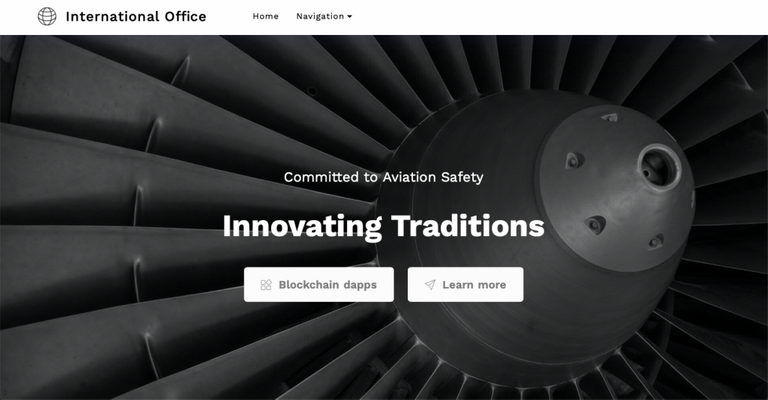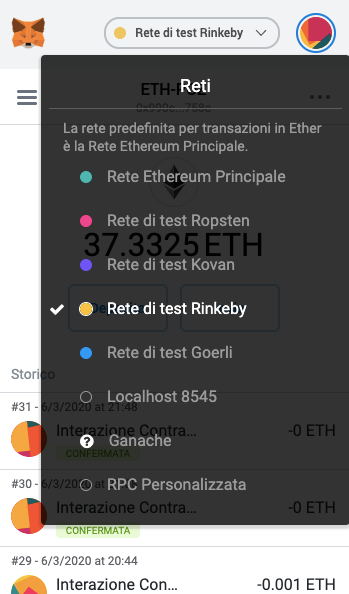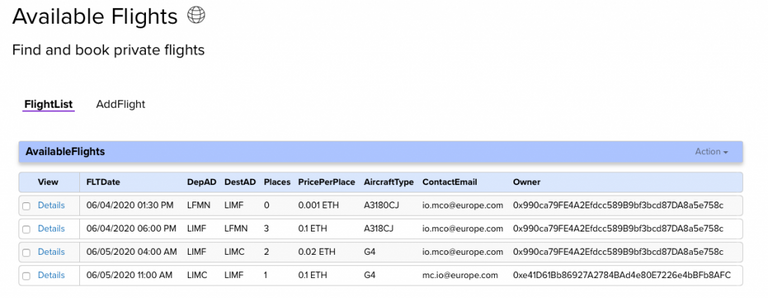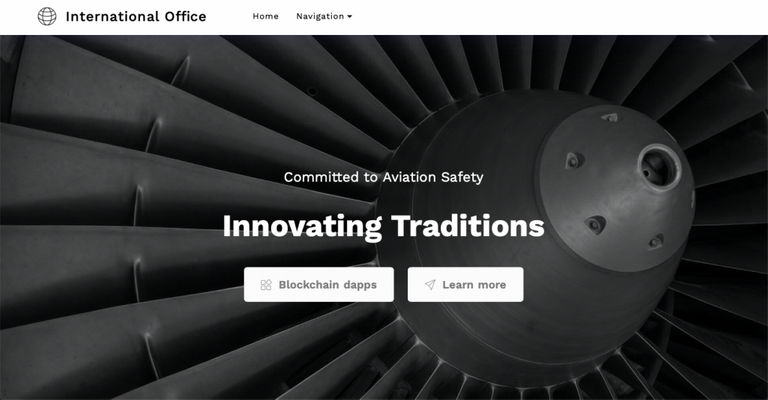
Text in English will follow
 Si parla sempre più spesso di blockchain per argomenti più o meno collegati alle criptovalute. Oggi vediamo come un'istituzione per sua stessa definizione particolarmente decentralizzata è in grado di utilizzare la tecnologia suddetta non solo per effettuare transazioni finanziarie.
Si parla sempre più spesso di blockchain per argomenti più o meno collegati alle criptovalute. Oggi vediamo come un'istituzione per sua stessa definizione particolarmente decentralizzata è in grado di utilizzare la tecnologia suddetta non solo per effettuare transazioni finanziarie.
Prima di tutto: l'ufficio internazionale è l' International Office: per chi ancora non lo conoscesse, è un organo formato da professionisti di varie nazioni per analizzare e valutare regolamenti e procedure aeronautiche al fine di garantire a tutti un trasporto aereo sicuro, legale ed efficiente, solitamente a costi contenuti.
La missione cosmopolita dell'ufficio negli ultimi anni si sta sempre più interessando a situazioni di carattere normativo e regolamentare anche al fine di permettere alle autorità nazionali ed internazionali il confronto con esperti qualificati che operano realmente nel settore.
Da anni si assiste al nascere di regolamentazioni sempre più frammentate a livello internazionale e nazionale, che creano non pochi problemi a chi decide di operare seguendo le norme (chi non le segue evidentemente non ne è così influenzato).
Sono nati pertanto diversi operatori più o meno regolari che operano spesso indisturbati a causa del complesso sistema regolamentare.
Una garanzia per gli utenti potrebbe essere proprio quella che si ottiene dalla tecnologia blockchain.
Un esempio su tutti: l'overbooking non dovrebbe essere tollerato e solo con un sistema di prenotazioni adeguato e tacciabile si potrà avere la garanzia di trasparenza che un utente si merita. C'è un lavoro del 2018 della IATA che sostanzialmente approva la tecnologia ma non si spinge molto più a fondo perchè di fatto è l'organizzazione che racchiude a livello internazionale quasi tutte le compagnie aeree e pertanto non ha convenienza ad agire a completo vantaggio degli utenti e degli operatori non aderenti.
Un certificato di qualsiasi tipo potrebbe ad esempio essere tacciabile direttamente sulla blockchain, dal suo rilascio e con tutte le sue modifiche: questo ne impedisce anche la falsificazione, a differenza di molti documenti cartacei.
Vediamo quindi cosa è stato fatto come dimostrazione tecnologica. Il sito dell' Ufficio è in Inglese ma è estremamente semplice e le app sono intuitive.
Prima di tutto la domanda da porsi è: dove collocare un server per ospitare l'interfaccia utente ovvero il sito?
La soluzione non è semplice ma esiste già un sistema distribuito nel quale collocare i file. Si chiama IPFS - ovvero Inter Planetary File System e dovrebbe in futuro sostituire completamente il protocollo HTTP.
Un file in IPFS è memorizzato semplicemente su alcuni "nodi", ovvero computers connessi alla rete. Non c'è quindi un server fisico con tutte le problematiche (temporanea assenza di corrente o di linea dati ad esempio) ed è accessibile attraverso un gateway con un indirizzo del tutto simile a quelli tradizionali anche se un po' più lungo - ma che si può accorciare, ne parleremo dopo. Ad esempio l'indirizzo del sito decentralizzato potrebbe avere una forma simile: https://gateway.ipfs.io/ipfs/QmZVcm2J5L88fXoZsLEzEBtdXqBB1eUXMKNpRQjL2KiKmf/

Ora esiste un sito che non risiede fisicamente su nessun server ma è distribuito su una rete di computer connessi tra loro. In altri termini il sito è stato delocalizzato su una rete peer to peer (ogni peer costituisce un nodo). Non ci sono particolari differenze per un utente tra un sito ospitato su un server ed uno delocalizzato per quanto riguarda l'aspetto dello stesso.
Il sito oltre a descrivere la missione dell'ufficio presenta anche tre d-app. Le d-app sono delle app decentralizzate, che utilizzano la blockchain per tenere traccia di quanto accade.
Abbiamo visto tre applicazioni: un sistema di tracciamento del tempo (si utilizza ad esempio quando un professionista dell'ufficio inizia o termina un compito), un servizio di messaggistica simile ad un piccolo forum ed infine una piattaforma di prenotazione voli: in quest'ultima d-app gli operatori possono inserire i posti disponibili sui propri aeromobili e gli utenti prenotarli pagando direttamente in ETH, la criptovaluta della blockchain Ethereum.
Ad oggi il sistema è in beta e non è collegato alla rete Ethereum principale bensì alla "testnet" Rinkeby: questa rete consente le stesse possibilità di tracciabilità ma non comporta l'utilizzo di ETH reali. Tutti possono accedervi ed utilizzare le app (tra l'altro gli operatori che inseriscono i voli sono ben contenti di offrire i posti inseriti sul sistema di prenotazione a chi vorrà prendere in questo modo dimestichezza con il sistema. Vediamo come fare ad utilizzarlo.
- Installare l'estensione "metamask" per il browser. Attualmente il sistema è disponibile per le operazioni solo da pc ma rimane comunque tutto visibile correttamente anche da dispositivi mobili.
- Creare il proprio "portafogli" (wallet) e collegarsi alla rete Rinkeby

Ora viene la parte un po' più difficile: occorre ottenere gratuitamente qualche ETH per poter effettuare le interazioni con le d-app. E' semplice, basta copiare il proprio indirizzo ETH da metamask (è quello in alto che inizia per 0x... ed incollarlo in questo messaggio che potrete postare sui vostri social (Facebook o Twitter):
This ETH address is for IO use: 0x32Be343B94f860124dC4fEe278FDCBD38C102D88
Ovviamente l'indirizzo deve essere il vostro, non quello generico riportato qui sopra.
A questo punto potrete copiare il link del vostro post (su Twitter è facile, su Facebook un po' più macchinoso ma non certo impossibile) ed incollarlo nella finestra di https://faucet.rinkeby.io cliccando quindi su "give me ether" (scegliete voi quanti). Se non funzionasse subito riprovate dopo qualche minuto o accertatevi di aver inserito il link corretto nella finestra del faucet (quella sotto la "doccia").
Ora le interazioni con le app dell'Ufficio Internazionale saranno possibili direttamente dal browser attraverso MetaMask.

Dimenticavo: l'indirizzo del sito è http://iomontecarlo.eth.link
 Blockchain is increasingly interesting for topics more or less related to cryptocurrencies. Today we will see how a decentralized institution is able to use the aforementioned technology not only to carry out financial transactions.
Blockchain is increasingly interesting for topics more or less related to cryptocurrencies. Today we will see how a decentralized institution is able to use the aforementioned technology not only to carry out financial transactions.
First of all: the International Office, for those who still do not know it, is a team by professionals from various nations who analyze and evaluate aeronautical regulations and procedures in order to guarantee to everyone a safe, legal and efficient air transport, usually very sustainable.
The cosmopolitan mission of the office in recent years has been increasingly interested in regulatory and legal affairs, in order to allow national and international authorities to know the point of view of qualified experts who actually work in the sector.
For years we have witnessed the emergence of increasingly fragmented regulations at international and national level, which create many problems for those who decide to operate following the rules (those who do not follow them obviously are not so affected).
Therefore, several -more or less regular- operators were born, often operating undisturbed due to the complex regulatory system.
A guarantee for users could be just what you get from blockchain technology.
One example above all: overbooking should not be tolerated anymore and only with an adequate and traceable booking system You can have the guarantee of transparency that a user deserves. There is a 2018 IATA work that basically approves the technology but does not go much deeper because IATA is the organization that encompasses almost all the airlines at an international level and therefore it does not have the convenience to act to the full advantage of the non-member users and operators.
For example, a certificate of any type could be directly traceable on the blockchain, since its release and with all its modifications: this also prevents its falsification, more frequent with paper documents.
So let's see what has been done as a technological demonstration.
First of all the question is: where can we place a server to host the user interface of the wsite?
The solution is not simple but there is already a distributed system in which it is possible to place the files. It's called IPFS - or Inter Planetary File System and should replace the HTTP protocol in the near future.
An IPFS file is simply stored on some "nodes", ie computers connected to the network. There is therefore no physical server - with its associated problems (temporary absence of power or data line for example)- and it is accessible through a gateway with an address similar to the traditional ones even if a little longer - but it can beshortened, we'll talk about it later. For example, the decentralized site address could have a similar form: https://gateway.ipfs.io/ipfs/QmZVcm2J5L88fXoZsLEzEBtdXqBB1eUXMKNpRQjL2KiKmf/

Now there is a site that does not physically reside on any server but it is distributed over a network of connected computers. In other words, the site has been relocated on a peer to peer network (each peer constitutes a node). There are no particular differences for a user between a site hosted on a server and one delocalized.
In addition to describing the mission of the office, the site also features three d-apps. D-apps are decentralized apps, which use the blockchain to track what is happening.
We have seen three applications: a time tracking system (used for example when an office professional starts or finishes a task), a messaging service similar to a small forum and finally a flight booking platform: in the latter d-app operators can enter the seats available on their aircraft and users can book them by paying directly in ETH, the cryptocurrency of the Ethereum blockchain.
To date, the system is in beta and it is not connected to the main Ethereum network but to the "testnet" Rinkeby: this network allows the same traceability possibilities of the main one but does not involve the use of real ETH. Everyone can access and use the apps (among other things, the operators who enter the flights are happy to offer the places entered on the booking system to those who want to become familiar with the system in this way). Let's see how to use it.
Install the "metamask" extension for the browser. Currently the system is available for operations only from PC but it is still visible correctly even from mobile devices.
Create your own "wallet" and connect to the Rinkeby network

Now it comes the slightly more difficult part: you will need to get some ETH for free to be able to interact with the d-apps. It's simple, just copy your ETH address from metamask (it's the top one that starts with 0x … and paste it in this message that you can post on your social networks (Facebook or Twitter):
This ETH address is for IO use: 0x32Be343B94f860124dC4fEe278FDCBD38C102D88
Obviously the address must be yours, not the generic one shown above.
At this point you can copy the link of your post (on Twitter it's easy, on Facebook a little more cumbersome but certainly not impossible) and paste it in the https://faucet.rinkeby.io window by clicking on "give me ether" (you choose how many). If it doesn't work immediately, try again after a few minutes or make sure you have entered the correct link in the faucet window (the one under the "shower").
Interactions with the International Office apps will now be possible directly from the browser through MetaMask.
Lest we forget: the address of the International Office website is http://iomontecarlo.eth.link
Posted by Personal Aviation with SteemPress : https://personalaviation.eu/2020/06/04/international-decentralized-office-ita-en/
!discovery 35
This post was shared and voted inside the discord by the curators team of discovery-it
Join our community! hive-193212
Discovery-it is also a Witness, vote for us here
Congratulations @omodei! You have completed the following achievement on the Hive blockchain and have been rewarded with new badge(s) :
You can view your badges on your board And compare to others on the Ranking
If you no longer want to receive notifications, reply to this comment with the word
STOPTo support your work, I also upvoted your post!
Do not miss the last post from @hivebuzz: